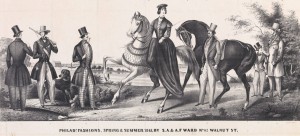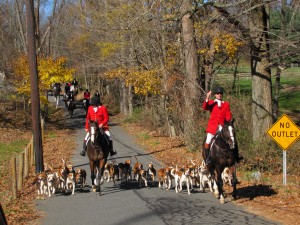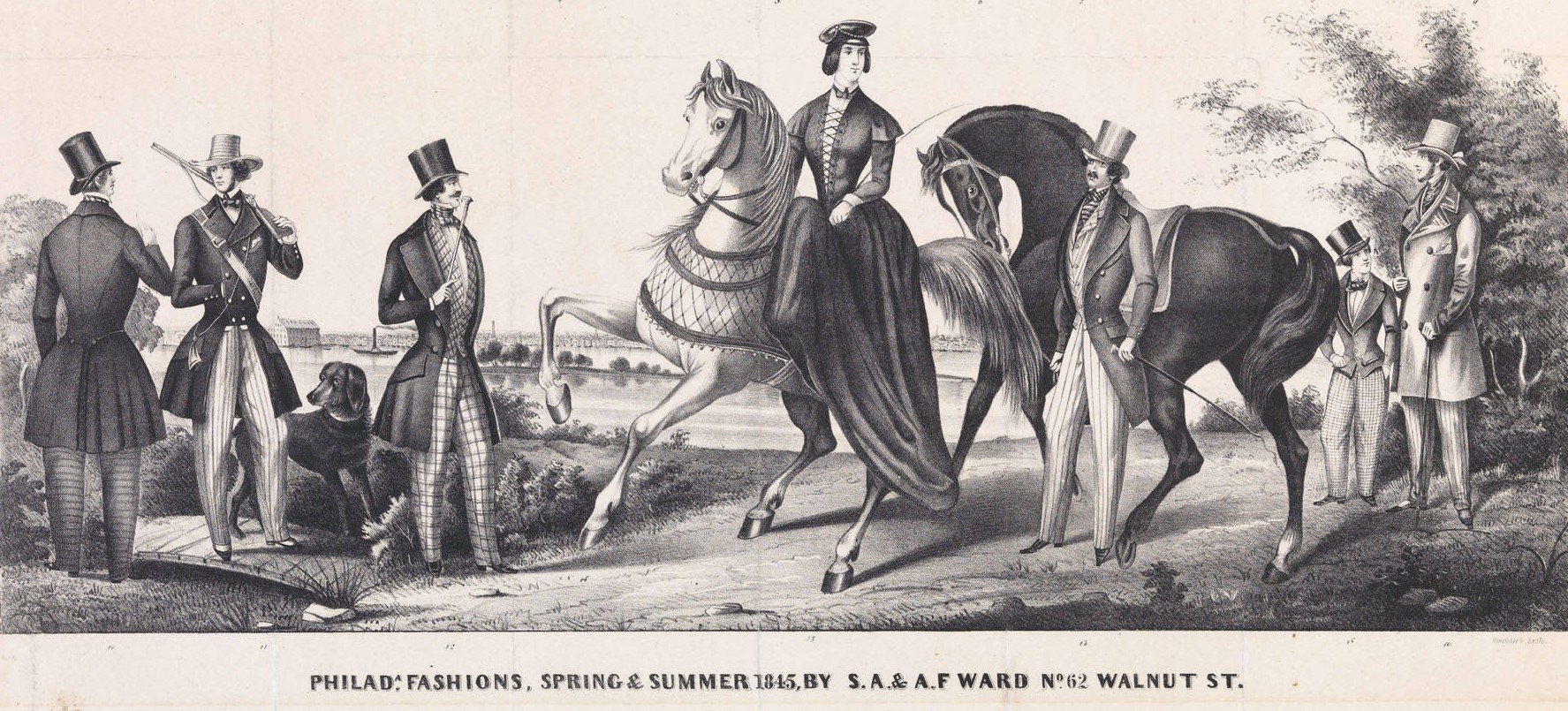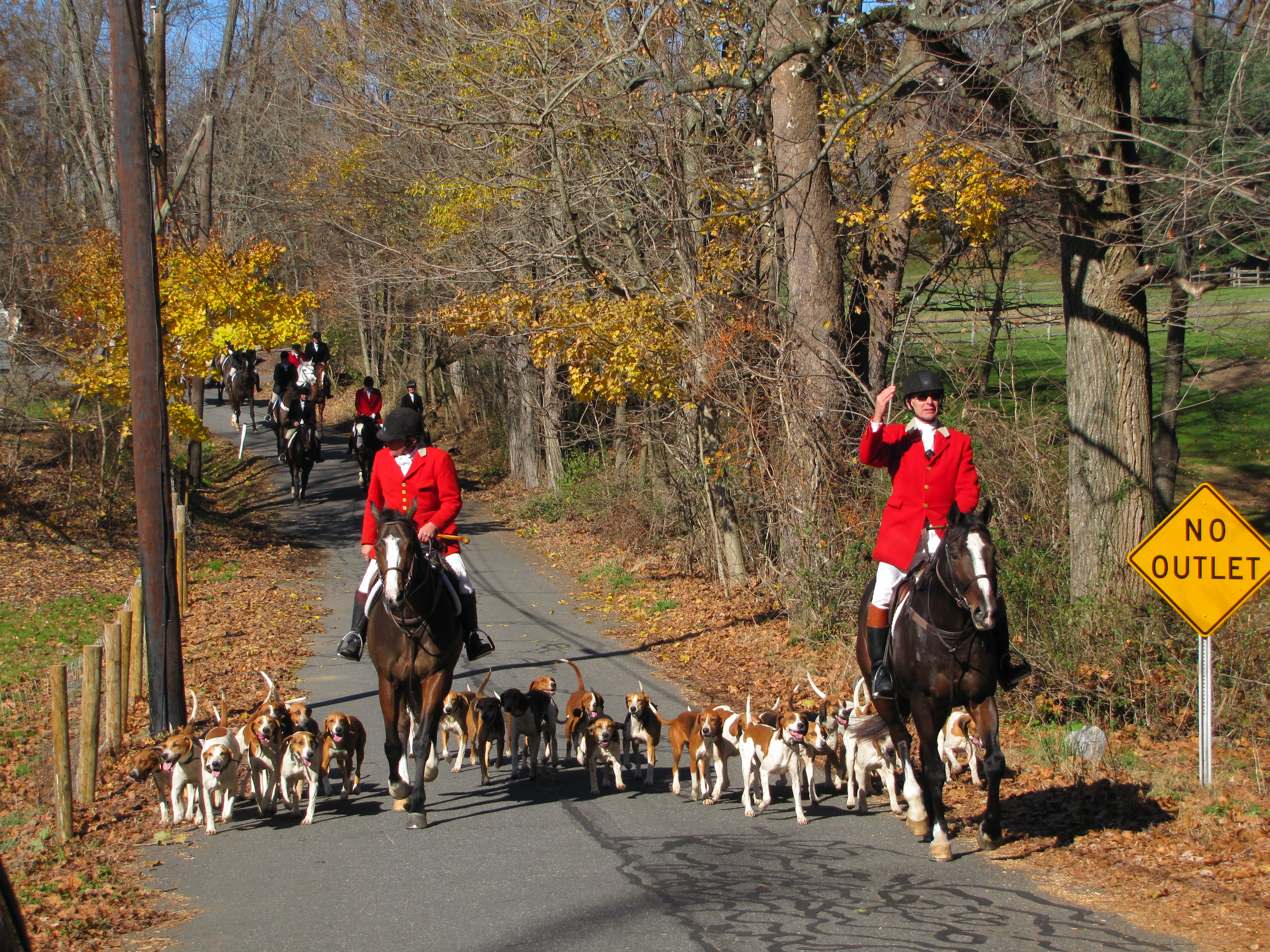Fox Hunting
By Doreen Skala
Essay
Fox hunting, the sport of mounted riders following a pack of hounds that are hunting a fox by scent, became a popular leisure activity of the emerging gentry in the Philadelphia region during the eighteenth and nineteenth centuries. It survives as a twenty-first-century pastime, even though development has reduced the available countryside, and animal-rights activists have sometimes challenged the practice.

Fox hunting was first brought to America in the early eighteenth century by visiting and transplanted English gentry in Maryland and Virginia. In Philadelphia, the Quakers outlawed fox hunting as a “rude” sport in their Great Law of Pennsylvania shortly after settlement in 1682. Even so, there were private hunts in southern New Jersey and southwestern Pennsylvania in the 1700s. As Quaker influence waned, fox hunting, the domain of the eighteenth-century gentry in England, gained popularity in Philadelphia as a leisure activity of the emerging colonial gentry who built grand estates and rode in fine carriages in imitation of their English counterparts. For the late-eighteenth- and early-nineteenth-century gentleman, a pack of foxhounds was as necessary an accoutrement as was a carriage or imported ceramics.
In October 1766, twenty-seven Philadelphia professionals, newly successful merchants and lawyers of Philadelphia, founded the Gloucester Fox Hunting Club, the first fox-hunting club in America. On Tuesday and Friday mornings before dawn between October and April, its members crossed the Delaware River by ferry, met for a hearty breakfast, and then hunted red and gray foxes in the forests, swamps, and farmlands of southern New Jersey with a pack bred from English foxhounds. This club was active from 1766 until 1818, except during the 1775–80 war years.
There were no organized hunts in the Philadelphia area between the time the Gloucester club disbanded and 1873, but there were a number of private packs. From the 1820s through the 1850s, captains of industry in Philadelphia were among the city men who had become country squires and owned private packs. Owning a large private pack was too costly for some, and so many merged their packs and shared the expense. Beginning in 1859, a pack of trencher-fed hounds was kenneled at the Rose Tree Inn barn during hunting season, returning to their respective homes when the season ended.
Rose Tree Hunt and Other Clubs
The Rose Tree Hunt was formed by gentlemen of Delaware and Chester counties in 1873, and over the next decades, a number of hunts sprang up. Radnor Hunt, the oldest continuous hunt club in the Philadelphia region as of 2013, was founded in 1883 with a pack of hounds owned by Quaker Thomas Mather. Lima was founded in 1885, Chester Valley in 1896, Upland in 1900, Brandywine in 1901, White Marsh in 1903, Pickering in 1910, Cheshire Hunt in 1912, Huntingdon Valley in 1914, and Vicmead, in Delaware, in 1920.
It was during this period that women joined the hunt. In fact, ladies rode with the Rose Tree Hunt as early as 1878. In the mid-Victorian era, hunting was considered unseemly for women, and it held real dangers for them owing to the side saddle that modesty prescribed. The invention of the safety skirt in 1875 and the apron skirt in the 1890s, along with the leaping horn and safety stirrup bar modifications for the side saddle, allowed women to participate more safely.

Over the course of the twentieth century, land for fox hunting diminished. Post-and-split-rail wood fencing increasingly gave way to wire as farming grew more intensive. The spread of housing developments, highways, shopping centers, and golf courses limited hunting country. Chester County, predominantly farm and pasture, had been ideal for fox hunting with its rolling hills, small copses, creeks and streams, and miles of open fields, much like England, though the new wire fencing made it, too, less and less hunter-friendly. In the first half of the century, Philadelphia continued to be the home of American gentry who indulged, except during the world wars, in elite recreational activities such as cricket, tennis, and fox hunting. After World War II, economic prosperity expanded suburban Philadelphia even farther, encroaching on the hunting grounds, so some clubs leased or purchased large tracts of rural land for private use. In the second half of the century, many of Philadelphia’s hunt clubs closed.
Devon Horse Show
As of 2021, four fox hunts remain active in the Philadelphia area, including the Radnor Hunt, Kimberton Hunt, Huntington Valley Hunt, and Cheshire Hunt. In addition, the area boasts several fox-hunting-inspired events known throughout the equine-minded world. The Bryn Mawr Hound Show, begun in 1914, promotes interest in the hound with shows and breeding information. The Devon Horse Show, begun in 1896 by Main Line fox hunting men, is one of the largest horse shows in America today. The Radnor Hunt Races, begun in 1930, brings together riders to compete in steeplechase racing, with the fences and ditches that a horse and rider would come across in the course of a fox hunt.
For all its traditional ritual and attire, the hunt has modernized. In colonial times, the hunt set out from the kennels on horseback before dawn to hunt over common land, and in modern times, it meets on privately-owned land about eleven o’clock with trailered hounds. In the eighteenth century, fox hunting was the pleasurable rural pursuit of gentlemen only, and in the twenty-first century, the hunt includes women, no longer riding sidesaddle, and children. Fans of fox hunting still come out to watch, but these “car hunters” use SUVs and 4x4s rather than carriages or horses to follow the hounds. While there has been some local debate about the state of fox hunting in America, particularly after the success of British environmentalists and animal-rights advocates in banning traditional fox hunting there in 2004, Philadelphians continue to ride to hounds as they have for more than 250 years, continuing traditions imported by the colonists.
Doreen Skala holds a master’s degree in history from Rutgers University with a focus in colonial and transatlantic history. Her research has been published as a book chapter and as an article at a British historical society. (Author information current at time of publication.)
Copyright 2013, Rutgers University

